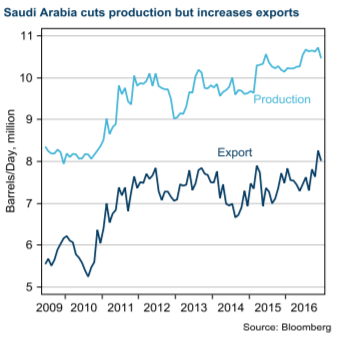Analys
Reflections from IP Week in London

![]() The atmosphere was far more upbeat at this year’s International Petroleum Week, given the sharp oil price increase since the previous IP gathering, with levels now considered healthy for the industry. Expectations are divided between three views: 1) the market will continue to trend toward USD 65 per barrel, which is the longterm cost trend and also the acquisition policy of many companies; 2) fall back to the marginal cost of production at USD 50, balancing around inventory held; or 3) hover between the two depending on the strength of one’s belief in the first two views. Few believe in oil breaking out of this price range in the short to medium term, so OPEC has clearly given the industry some time to breathe. However, the short-lived price recovery is already in danger as OPEC and Russia fail to deliver on agreed cuts and as US shale oil roars back to life.
The atmosphere was far more upbeat at this year’s International Petroleum Week, given the sharp oil price increase since the previous IP gathering, with levels now considered healthy for the industry. Expectations are divided between three views: 1) the market will continue to trend toward USD 65 per barrel, which is the longterm cost trend and also the acquisition policy of many companies; 2) fall back to the marginal cost of production at USD 50, balancing around inventory held; or 3) hover between the two depending on the strength of one’s belief in the first two views. Few believe in oil breaking out of this price range in the short to medium term, so OPEC has clearly given the industry some time to breathe. However, the short-lived price recovery is already in danger as OPEC and Russia fail to deliver on agreed cuts and as US shale oil roars back to life.
US shale oil in great shape
The US is now the swing producer, and shale oil cost cuts, technology development and efficiency gains are astonishing across all basins. All wells that are able to drill will be active at current prices. Breakeven numbers are as low as USD 35/bbl with an average of about USD 40 (at 20% RoR), which is lower than some OPEC averages. Also, the effects of transportation infrastructure spending are now being seen: the latest statistics show a huge surge in oil exports this year with far more going to Asia. Technology development will increase yields, so even if US rig counts (now 741) are interesting, we believe it makes less sense to focus on this, as productivity per rig has soared tenfold since 2010 and will continue to grow. Permian fields account for most of the growth whereas Eagle Ford production is nearly flat. New capacity of 600,000 barrels is expected from US shale oil this year, with production expected to reach 4.87 million bbl/d in March. It is also worth mentioning that this trend started way before OPEC’s discussion on cuts.
OPEC compliance with production cuts was widely discussed. Shipping data evidence suggests that cuts are nowhere near the OPEC numbers of 93 percent, but rather closer to 40 percent, considering that Iraq, Venezuela, Algeria and the United Arab Emirates are over their reference levels, and non-OPEC producers such as Russia are showing only a third of its proposed 300,000 bbl cut and pleading for more time. How long will Saudi Arabia be over-compliant? Even if Saudi production numbers are down, exports are not falling as much, due to a domestic switch from oil to gas to cover Saudi energy needs. There has been a sharp reduction in Nigerian pipeline vandalism, with no major incidents reported so far this year. The government has implemented 20 key steps to end incidents by continued amnesty payments to former rebels, increasing security and closer dialogue with militants. In all, OPEC is not showing enough production cuts, and it seems very likely that the deal will be extended to OPEC in May to curb stocks, even if the market has fallen into backwardation again. Stock overhang is expected to be eliminated by Q4 2017 based on global demand/production growth of about 2:1, leaving a shortage of just below 1 million bbl/d this year.
Chinese demand outlook
How sustainable is Asian demand, and Chinese in particular, with imports equivalent to nearly two thirds of global demand growth last year? Chinese demand is likely to rise at a gentler pace, at around 3% or 600,000 bbl, when the economy is starting to slow again as authorities tap the brakes after another credit-driven boom, and as car sales are down this year along with tax incentives for small cars. It will also be interesting to follow government support for infrastructure spending to shore up GDP growth before the Communist Party´s 19th congress in October, helping to underpin demand.
Trump is everywhere
The Trump administration also creates a measure of uncertainty over the outlook for oil prices, first on demand and whether there will be a boost of stimulus in the US. Second is the possibility of new sanctions against Iran, which has been allowed to raise its output to 3.8 million bbl/d under the OPEC deal and regained market share in Asia-Pacific and Europe as rival OPEC producers cut supply and as sanctions were lifted.
Analys
Fear that retaliations will escalate but hopes that they are fading in magnitude

Brent crude spikes to USD 90.75/b before falling back as Iran plays it down. Brent crude fell sharply on Wednesday following fairly bearish US oil inventory data and yesterday it fell all the way to USD 86.09/b before a close of USD 87.11/b. Quite close to where Brent traded before the 1 April attack. This morning Brent spiked back up to USD 90.75/b (+4%) on news of Israeli retaliatory attack on Iran. Since then it has quickly fallen back to USD 88.2/b, up only 1.3% vs. ydy close.

The fear is that we are on an escalating tit-for-tat retaliatory path. Following explosions in Iran this morning the immediate fear was that we now are on a tit-for-tat escalating retaliatory path which in the could end up in an uncontrollable war where the US unwillingly is pulled into an armed conflict with Iran. Iran has however largely diffused this fear as it has played down the whole thing thus signalling that the risk for yet another leg higher in retaliatory strikes from Iran towards Israel appears low.
The hope is that the retaliatory strikes will be fading in magnitude and then fizzle out. What we can hope for is that the current tit-for-tat retaliatory strikes are fading in magnitude rather than rising in magnitude. Yes, Iran may retaliate to what Israel did this morning, but the hope if it does is that it is of fading magnitude rather than escalating magnitude.
Israel is playing with ”US house money”. What is very clear is that neither the US nor Iran want to end up in an armed conflict with each other. The US concern is that it involuntary is dragged backwards into such a conflict if Israel cannot control itself. As one US official put it: ”Israel is playing with (US) house money”. One can only imagine how US diplomatic phone lines currently are running red-hot with frenetic diplomatic efforts to try to defuse the situation.
It will likely go well as neither the US nor Iran wants to end up in a military conflict with each other. The underlying position is that both the US and Iran seems to detest the though of getting involved in a direct military conflict with each other and that the US is doing its utmost to hold back Israel. This is probably going a long way to convince the market that this situation is not going to fully blow up.
The oil market is nonetheless concerned as there is too much oil supply at stake. The oil market is however still naturally concerned and uncomfortable about the whole situation as there is so much oil supply at stake if the situation actually did blow up. Reports of traders buying far out of the money call options is a witness of that.
Analys
Fundamentals trump geopolitical tensions

Throughout this week, the Brent Crude price has experienced a decline of USD 3 per barrel, despite ongoing turmoil in the Middle East. Price fluctuations have ranged from highs of USD 91 per barrel at the beginning of the week to lows of USD 87 per barrel as of yesterday evening.

Following the release of yesterday’s US inventory report, Brent Crude once again demonstrated resilience against broader macroeconomic concerns, instead focusing on underlying market fundamentals.
Nevertheless, the recent drop in prices may come as somewhat surprising given the array of conflicting signals observed. Despite an increase in US inventories—a typically bearish indicator—we’ve also witnessed escalating tensions in the Middle East, coupled with the reinstatement of US sanctions on Venezuela. Furthermore, there are indications of impending sanctions on Iran in response to the recent attack on Israel.
Treasury Secretary Janet Yellen has indicated that new sanctions targeting Iran, particularly aimed at restricting its oil exports, could be announced as early as this week. As previously highlighted, we maintain the view that Iran’s oil exports remain vulnerable even without further escalation of the conflict. It appears that Israel is exerting pressure on its ally, the US, to impose stricter sanctions on Iran, an action that is unfolding before our eyes.
Iran’s current oil production stands at close to 3.2 million barrels per day. Considering additional condensate production of about 0.8 million barrels per day and subtracting domestic demand of roughly 1.8 million barrels per day, the net export of Iranian crude and condensate is approximately 2.2 million barrels per day.
However, the uncertainty surrounding the enforcement of such sanctions casts doubt on the likelihood of a complete ending of Iranian exports. Approximately 80% of Iran’s exports are directed to independent refineries in China, suggesting that US sanctions may have limited efficacy unless China complies. The prospect of China resisting US pressure on its oil imports from Iran poses a significant challenge to US sanctions enforcement efforts.
Furthermore, any shortfall resulting from sanctions could potentially be offset by other OPEC nations with spare capacity. Saudi Arabia and the UAE, for instance, can collectively produce an additional almost 3 million barrels of oil per day, although this remains a contingency measure.
In addition to developments related to Iran, the Biden administration has re-imposed restrictions on Venezuelan oil, marking the end of a six-month reprieve. This move is expected to impact flows from the South American nation.
Meanwhile, US crude inventories (excluding SPR holdings) surged by 2.7 million barrels last week (page 11 attached), reaching their highest level since June of last year. This increase coincided with a decline in measures of fuel demand (page 14 attached), underscoring a slightly weaker US market.
In summary, while geopolitical tensions persist and new rounds of sanctions are imposed, our market outlook remains intact. We maintain our forecast of an average Brent Crude price of USD 85 per barrel for the year 2024. In the short term, however, prices are expected to hover around the USD 90 per barrel mark as they navigate through geopolitical uncertainties and fundamental factors.
Analys
Brace for Covert Conflict

In the past two trading days, Brent Crude prices have fluctuated between highs of USD 92.2 per barrel and lows of USD 88.7 per barrel. Despite escalation tensions in the Middle East, oil prices have remained relatively stable over the past 24 hours. The recent barrage of rockets and drones in the region hasn’t significantly affected market sentiment regarding potential disruptions to oil supply. The key concern now is how Israel will respond: will it choose a strong retaliation to assert deterrence, risking wider regional instability, or will it revert to targeted strikes on Iran’s proxies in Lebanon, Syria, Yemen, and Iraq? While it’s too early to predict, one thing is clear: brace for increased volatility, uncertainty, and speculation.

Amidst these developments, the market continues to focus on current fundamentals rather than unfolding geopolitical risks. Despite Iran’s recent attack on Israel, oil prices have slid, reflecting a sideways or slightly bearish sentiment. This morning, oil prices stand at USD 90 per barrel, down 2.5% from Friday’s highs.
The attack
Iran’s launch of over 300 rockets and drones toward Israel marks the first direct assault from Iranian territory since 1991. However, the attack, announced well in advance, resulted in minimal damage as Israeli and allied forces intercepted nearly all projectiles. Hence, the damage inflicted was limited. The incident has prompted US President Joe Biden to urge Israel to exercise restraint, as part of broader efforts to de-escalate tensions in the Middle East.
Israel’s response remains uncertain as its war cabinet deliberates on potential courses of action. While the necessity of a response is acknowledged, the timing and magnitude remain undecided.
The attack was allegedly in retaliation for an Israeli airstrike on Iran’s consulate in Damascus, resulting in significant casualties, including a senior leader in the Islamic Revolutionary Guard Corps’ elite Quds Force. It’s notable that this marks the first direct targeting of Israel from Iranian territory, setting the stage for heightened tensions between the two nations.
Despite the scale of the attack, the vast majority of Iranian projectiles were intercepted before reaching Israeli territory. However, a small number did land, causing minor damage to a military base in the southern region.
President Biden swiftly condemned Iran’s actions and pledged to coordinate a diplomatic response with leaders from the G7 nations. The US military’s rapid repositioning of assets in the region underscores the seriousness of the situation.
Iran’s willingness to escalate tensions further depends on Israel’s response, as indicated by General Mohammad Bagheri, chief of staff of the Iranian armed forces. Meanwhile, speculation about a retaliatory attack from Israel persists.
Looking ahead, key questions remain unanswered. Will Iran launch additional attacks? How will Israel respond, and what implications will it have for the region? Moreover, how will Iran’s allies react to the escalating tensions?
Given the potential for a full-scale war between Iran and Israel, concerns about its impact on global energy markets are growing. Both the United States and China have strong incentives to reduce tensions in the region, given the destabilizing effects of a regional conflict.
Our view in conclusion
The recent escalation between Iran and Israel underscores the delicate balance of power in the volatile Middle East. With tensions reaching unprecedented levels and the specter of further escalation looming, the potential for a full-blown conflict cannot be understated. The ramifications of such a scenario would be far-reaching and could have significant implications for regional stability and global security.
Turning to the oil market, there has been much speculation about the possibility of a full-scale blockade of the Strait of Hormuz in the event of further escalation. However, at present, such a scenario remains highly speculative. Nonetheless, it is crucial to note that Iran’s oil production and exports remain at risk even without further escalation. Currently producing close to 3.2 million barrels per day, Iran has significantly increased its production from mid-2020 levels of 1.9 million barrels per day.
In response to the recent attack, Israel may exert pressure on its ally, the US, to impose stricter sanctions on Iran. The enforcement of such sanctions, particularly on Iranian oil exports, could result in a loss of anywhere between 0.5 million to 1 million barrels per day of oil supply. This would likely keep the oil market in deficit for the remainder of the year, contradicting the Biden administration’s wish to maintain oil and gasoline prices at sustainable levels ahead of the election. While other OPEC nations have spare capacity, utilizing it would tighten the global oil market even further. Saudi Arabia and the UAE, for example, could collectively produce an additional almost 3 million barrels of oil per day if necessary.
Furthermore, both Iran and the US have expressed a desire to prevent further escalation. However, much depends on Israel’s response to the recent barrage of rockets. While Israel has historically refrained from responding violently to attacks (1991), the situation remains fluid. If Israel chooses not to respond forcefully, the US may be compelled to promise stronger enforcement of sanctions on Iranian oil exports. Consequently, Iranian oil exports are at risk, regardless of whether a wider confrontation ensues in the Middle East.
Analyzing the potential impact, approximately 2.2 million barrels per day of net Iranian crude and condensate exports could be at risk, factoring in Iranian domestic demand and condensate production. The effectiveness of US sanctions enforcement, however, remains uncertain, especially considering China’s stance on Iranian oil imports.
Despite these uncertainties, the market outlook remains cautiously optimistic for now, with Brent Crude expected to hover around the USD 90 per barrel mark in the near term. Navigating through geopolitical tensions and fundamental factors, the oil market continues to adapt to evolving conflicts in the Middle East and beyond.
-

 Nyheter2 veckor sedan
Nyheter2 veckor sedanGuldpriset når nytt all time high och bryter igenom 2300 USD
-

 Nyheter4 veckor sedan
Nyheter4 veckor sedanGuld toppar 2200 USD per uns
-

 Nyheter3 veckor sedan
Nyheter3 veckor sedanLundin Mining får köprekommendation av BMO
-

 Nyheter4 veckor sedan
Nyheter4 veckor sedanVertikal prisuppgång på kakao – priset toppar nu 9000 USD
-

 Nyheter2 veckor sedan
Nyheter2 veckor sedanCentralbanker fortsatte att köpa guld under februari
-

 Nyheter4 veckor sedan
Nyheter4 veckor sedanKaffepriserna stiger på lågt utbud och stark efterfrågan
-

 Nyheter2 veckor sedan
Nyheter2 veckor sedanHur mår den svenska skogsbraschen? Två favoritaktier
-

 Nyheter2 veckor sedan
Nyheter2 veckor sedanKakaomarknaden är extrem för tillfället









